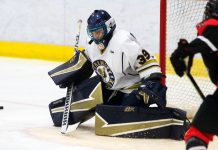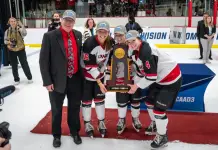The issue of amateurism deregulation and its impact on college hockey, followed by USCHO for the last 18 months, is about to come to a head. The subcommittee in charge of creating the legislation’s language is meeting one last time to work on tweaks based upon concerns heard at the NCAA’s January meetings.
To summarize: the series of legislative initiatives, known as the Deregulation of Amateurism, would allow players to sign a contract, accept prize money and enter a professional draft before entering college without jeopardizing their future NCAA eligibility. The idea is that the aforementioned things do not present an unfair advantage, in and of themselves, and should not be grounds for ineligibility.
This, the NCAA hoped, would benefit the student-athlete that often got lost in the association’s bureaucracy. The only basis for ineligibilty under the new legislation would be the number of years past your high school graduation year (18 years old), in which you participated competitively in your sport. This would prevent, for example, a 22-year old European enrolling as a freshman basketball player, something the NCAA determined provides a much more direct competitive advantage than the concept of entering a draft.
While this seems like a winning situation for most American student-athletes, it drastically changes the recruiting playing field, especially in the big-time sports. There was a rather outspoken contingent that came out against the legislation during the January meetings, particularly basketball coaches who believe its passing could open a can of worms.
But the subcommittee put in charge of creating the legislation is standing behind it.
“The subcommittee still believes firmly in the legislation,” says Lisa Dehon, staff liaison to the subcommittee on Amateurism and Agents, “mostly that it would be best for prospective student-athletes.”
The implications of the initial legislation were particularly negative for hockey, however. That’s because many, if not most, hockey players don’t enter college until after having played junior and prep school hockey, well after their 18th birthday. All of those players would have been required to sit a year in residence, and lose a year of NCAA eligibility.
The outcry from the hockey world was immediate, but it prompted a rarely seen cooperation between the hockey community and the NCAA to rectify the situation. Hockey administrators were quickly invited to speak to the subcommittee and explain their issues, and an amendment was made that exempted those players.
“We do not have an ice hockey expert on the committee, and once we made the decision to try and understand as much as we could, we relied on the commissioners and others in hockey to tell us how hockey as a sport operates,” said Christine Grant, subcommittee chair and women’s athletic director at Iowa. “I received a great education on ice hockey.”
Harvard coach Mark Mazzoleni says, “Our association lobbied the right people. The coaches on this thing were ready.”
There was still one remaining major implication, however; the opening of doors to Canadian major junior players to enter college without penalty. Currently, the NCAA considers those players to be semi-professional, and once playing major junior, you can’t enroll and play at a U.S. college without severe penalties. Under the new legislation, what you did before age 18 wouldn’t have mattered.
This newfound freedom for previous major junior players was hailed by many insiders and fans as a major victory for college hockey. Now, players once stuck in the major junior system, could leave for U.S. colleges at will, opening up a new source of recruits.
This is what everyone wanted, right? The ability to recapture players that get sucked away to the major junior system, sometimes at 15 years old, before college recruiters could even contact them?
However, there is a sizable contingent of college coaches, perhaps half or more, who believe this is a very bad idea for college hockey.
“There are leagues — Hockey East was one — that were split,” says Joe Bertagna, commissioner of Hockey East and director of the American Hockey Coaches Association (AHCA). “Some like it, others are saying it’s bad. Without a penalty to pay [for going to major junior to begin with], you may never get them back.”
With these concerns in mind, Dehon and fellow NCAA staff liaison Bill Saum went to the annual coaches’ convention in Naples, Fla., last April to listen to the concerns of all sides.
“It was a pretty lively session as people started to realize the implications of everything,” says Bertagna.
“[The commissioners] went out to lunch with them after the formal session with the coaches. They came away from the trip on their own thinking there’s one more thing they have to do.”
What the subcommittee did, then, was put in another amendment, that players in major junior at age 16 and 17 could still leave for college, but would still have to sit a year in residence and lose a year of NCAA eligibility for each year of juniors played.
This caught many hockey people by surprise. They say Dehon and Saum left the meetings without any indication of what they would do, then suddenly, last summer, the change was made.
“We never came to a single position [at the meetings],” says Bertagna. “So when we heard about [the amendment], we thought, ‘Where did that come from?'”
Nonetheless, Dehon and the subcommittee believed this was a compromise position.
“We heard from both camps,” Dehon says. “It appeared to us that there was still a significant concern with the U.S. hockey community that major juniors can recruit at such a young age, and kids make decisions, and they were fearful of kids going into the major junior system before they were interested in college. The new proposal is still a significant proposal, but it allows for an individual that has made a mistake to still have college eligibility. It served both purposes.”
Ironically, the factions for and against allowing major junior players to join the collegiate ranks point to the same reasons.
The latter seems to be protecting the interests of the players, while the former seems bent on protecting college hockey’s interests. But that’s not an entirely fair assessment.
Sure, the rules would allow a player sucked into the major junior system to leave after a couple of years. But, say those against opening the doors, there are real concerns that major junior teams would restrict NCAA teams’ access to those players, causing them to be stuck there anyway.
“The problem is, you let a kid go, they are not going to accomodate his academic needs. And they’re going to taint him,” says Mazzoleni, who believes college programs are gaining ground on major juniors. “They are going to have morning practices, which is going to hurt him academically. They’re not going to let you visit the kid — how are you even going to recruit the kid? And they’re going to get him in their environment and you’re never going to get him back.
Does Mazzoleni still feel bad about a kid who gets stuck early, after having to make a decision at 15 years old?
“They know the rules,” he says.
“The biggest problem is the Grade 12 year, because kids are ready. They’re maybe better than what Tier II hockey is, so they don’t want to play Tier II because they want to continue to accelerate their game. So instead of being patient [they jump]. That’s the one things that kills college.”
Despite the major junior debate, there’s been a distinct feel-good atmosphere created between the NCAA and college hockey. The amount of cooperation between the two sides has been unprecedented. What started out as ignorance of college hockey by the committee, and a fear by the hockey people of the NCAA’s heavy hand, quickly became a love-fest.
“What I heard before I was a commissioner was that the NCAA would do whatever it wanted to do,” CCHA commissioner Tom Anastos said to the NCAA News. “But our voice was definitely requested. I learned in this process that you could be heard. I applaud the NCAA’s willingness to take the time to learn what our differences were and help us come to a solution.”
NCAA President Cedric Dempsey said, “While some in the hockey community may have a certain level of discomfort about the amateurism deregulation, they have never refused to make their own recommendations or consider alternatives. I believe that as a result of this invaluable partnership, the amateurism proposals address the unique aspects and concerns of ice hockey and show what can be accomplished.”
With these changes, however, we are left with legislation that, at this point, has been largely gutted as it pertains to hockey. Still, there are some aspects that will have positive effects for prospective student athletes.
For example, being able to sign a contract or enter a draft, and still enroll in college will let kids feel out their chances, and then go to college if it appears there is not enough money or opportunity to be had in the pros. This is good, because a player should not be dissuaded from attending college just because they put out feelers on their career. Why would you want to prevent kids from going to college?
But as we near a final vote of the Management Council at the April NCAA convention, the legislation’s future is uncertain. While the issue of major junior eligibilty was clearly the biggest point of contention in college hockey, other concerns are casting into doubt whether the legislation will pass at all.
The part about accepting prize money is still the biggest hangup. Basketball coaches are afraid, but haven’t been specific. In general, they are simply afraid that the new legislation will cause more problems than it solves.
“We’ve tried to ask them on numerous occasions to pinpoint their concerns, and to date we only get, ‘We hate all of it,'” says Dehon. “It’s difficult to find a compromise that way.”
A far cry from the hockey community.
“Tell me about it. They are the poster child for cooperation. It’s two groups coming together and educating each other,” Dehon says.
The question, at this point, is whether the basketball coaches have enough influence on their athletic directors and conference commissioners that make up the Management Council.
“That’s the $64,000 question. I’m still optimistic,” says Dehon.
“There are some concerns and issues that are still out there. Hopefully we can consider and address those issues in such a way that will make people more comfortable with the proposals. Even without that, the subcommittee will say it’s a good package. We’ll deal with the concerns that are quantifiable, rather than worst-case senarios. You can always come up with one [of those], but they’re hard to address.”
Bertagna adds, “We’re battling decades of comfort level over thinking what’s bad.”
With all the hockey-specific amendments, whatever happens, there probably won’t be the kind of monumental change that was originally anticipated, and/or feared.
“At this point, people really want to know what is going to happen,” said ECAC commissioner Phil Buttafuoco to the NCAA News. “Major junior leagues are using the amateurism proposals against us in the recruiting wars. It needs to be voted on.”
If, after years of work, the legislation is shot down in April, how will the subcommittee react?
“The subcommittee will feel victory in knowing they did the job that was to be done,” says Dehon. “But there will be a sense of loss that we had a chance to help student-athletes and it didn’t work out.”


